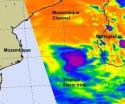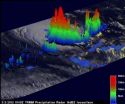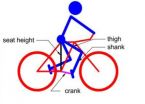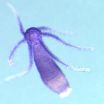(Press-News.org) The AIRS instrument on NASA's Aqua satellite provided forecasters with an infrared look at what was happening "under the hood" of Tropical Storm Irina's clouds and saw two reasons why it temporarily weakened before moving into the Mozambique Channel and heading for landfall in Mozambique in a couple of days.
WHY DID IT WEAKEN?
NASA's Aqua satellite's Atmospheric Infrared Sounder (AIRS) instrument captured an infrared image of Tropical Cyclone Irina over the Mozambique Channel on March 1, 2012 at 0130 UTC (8:30 p.m. EST, Feb. 29). At that time, the strongest thunderstorms were around the center of circulation and had become much smaller in area and displaced from the center as a result of interaction with the land of southwestern Madagascar and wind shear, respectively.
WHERE IS IRINA?
On March 2, 2012 at 1500 UTC (5 p.m. local time) the center of Irina was in the Mozambique Channel, almost half-way to Mozambique. The distance between Toliara, Madagascar and Maputo, Mozambique across the channel is 719 miles (1,158 km). It was located 425 nautical miles (489 miles/787 km) northeast of Maputo, Mozambique, near 24.5 South and 39.6 East.
NASA AIRS scientist Ed Olsen at NASA's Jet Propulsion Laboratory in Pasadena, Calif. looked at the last two days of satellite imagery. Olsen said, "If you compare the satellite microwave imagery from the Aqua satellite's ascending pass of March 2 with that from descending pass of March 1, you can see that the strongest convection cell (which was just on the west coast of Madagascar) has disappeared. Also, the rain band structure has also disappeared. However, on March 2 you see a strengthening convection cell in the Mozambique Channel at about 41 East, 25 South. This may be the indication of the final intensification before landfall in Mozambique. The structure of the storm is very asymmetrical and there is no 'warm core,' which would indicate strong convection in the circulation center."
NASA AIRS infrared satellite imagery on March 2 showed Irina's low-level circulation center is now partially exposed to outside winds, making it open for weakening by wind shear. Olsen said that the infrared satellite data agrees with the microwave satellite data, and shows the main area of showers and thunderstorms are now southeast of the center, which means that wind shear from the northwest are taking a toll.
HOW DOES WIND SHEAR AFFECT CYCLONE IRINA?
Think of a cyclone as a haystack. Its circular winds are "stacked" up on top of each other at different heights in the atmosphere. When wind shear enters the picture, it's like having a giant fan blowing at one height, say the middle of the haystack. When that happens, the haystack, like the tropical cyclone cannot support itself and becomes structurally weaker. That's what has happened with Irina today. However, wind shear is expected to wane in the next two days.
Maximum sustained winds are currently near 50 knots (~58 mph/~93 kph), weaker than yesterday because of the storm center's close proximity to the southwestern coast of Madagascar and because it drifted closer to an area of higher wind shear (up to 20 knots/23 mph/37 kph).
However, Irina continues moving away from the coast at 17 knots (~20 mph/~32 kph), so it is expected to intensify because of the warm waters in the Mozambique Channel over the next day or two. Irina is expected to intensify slightly, but remain a tropical storm until it makes landfall.
CURRENT FORECAST TRACK
Irina is expected to begin affecting coastal Mozambique before 1200 UTC (2 p.m. Local time, Mozambique) on March 3, with rough surf, gusty winds and moderate to heavy rainfall. Irina is currently creating seas of 20 feet (~6 meters) in the southern Mozambique Channel, and those rough seas that will affect the Mozambique coast.
The Joint Typhoon Warning Center forecasts Irina to track along the southeastern coast from Inhambane, Quissico, Chibuto and move inland just north of Maputo by March 5 at 0000 UTC (just after midnight local time on March 5) so it will be an overnight landfall. It is then expected to move west-southwest and dissipate quickly over Mozambique.
INFORMATION:
NASA sees tropical storm Irina hit by wind shear, headed for Mozambique
2012-03-05
ELSE PRESS RELEASES FROM THIS DATE:
NASA's TRMM satellite sees remnants of Tropical Cyclone 15S's 'difficult childhood'
2012-03-05
Tropical Cyclone 15S has had a difficult "childhood." It was born on March 1 and immediately dealt with a harsh environment. The cyclone weakened within 24 hours to a remnant low pressure area, and NASA's TRMM satellite revealed there was still some strength remaining in the storm.
The Tropical Rainfall Measuring Mission (TRMM) satellite passed over the remnants of Tropical Cyclone 15S in the South Indian Ocean on March 2, 2012 at 0140 UTC (8:40 p.m. EST, March 1). A rainfall analysis from TRMM's Microwave Imager (TMI) and Precipitation Radar (PR) instruments showed very ...
The future of plant science – a technology perspective
2012-03-05
Washington, D.C. -- Plant science is key to addressing the major challenges facing humanity in the 21st Century, according to Carnegie's David Ehrhardt and Wolf Frommer. In a Perspective published in The Plant Cell, the two researchers argue that the development of new technology is key to transforming plant biology in order to meet human needs.
Plants serve as the conduit of energy into the biosphere, provide food and materials used by humans, and they shape our environment. According to Ehrhardt and Frommer, the three major challenges facing humanity in our time are ...
When your ship comes in
2012-03-05
Every day, thousands of cargo containers from around the world pass through our nation's sea ports carrying items we need, and possibly some that are not so welcome: drugs, explosives, chemical, biological, or radiological weapons – even human cargo.
The possible concealment of such items in containers led lawmakers to call for the screening of all ocean cargo containers—thousands per port per day. The Department of Homeland Security's (DHS) U.S. Customs and Border Protection (CBP) is charged with the critical task of securing the country from terrorists and their ...
A new optimum design method of bicycle parameters for a specified person
2012-03-05
The optimum design of bicycle parameters has been explored by many scholars and institutes since bicycles were first invented. Professor Xin-Jun Liu and his group at Tsinghua University established a new way to design bicycle parameters according to the dimensions of the rider's body. They introduced a new perspective of the rider–bicycle system by considering the complete system as a mechanism. The group then established a new method for the optimum design of bicycle parameters from a completely theoretical basis, which may result in a new field of optimum design of bicycle ...
National Sleep Foundation poll explores transportation workers' sleep
2012-03-05
WASHINGTON, DC, March 3, 2012 – The people we trust to take us or our loved ones from place to place struggle with sleep, according to the National Sleep Foundation's (NSF) 2012 Sleep in America® poll. It is the first poll to ask transportation professionals, including pilots, train operators,* truck, bus, taxi and limo drivers about their sleep habits and work performance.
Pilots and train operators are most likely to report sleep-related job performance and safety problems.
The results of the poll are striking. About one-fourth of train operators (26%) and pilots (23%) ...
Ice hockey feels the heat in Canada
2012-03-05
The future of Canadian outdoor ice hockey – a sport synonymous with the country's culture – is being threatened by anthropogenic climate change, new research suggests.
As warmer winter temperatures restrict ice from freezing over, researchers believe the ice hockey stars of the future will have limited access to the frozen lakes and backyard rinks that have helped shape the careers of some of the greatest professional players, such as Wayne Gretzky; the Canadian considered to be the greatest of all time who started skating as a child on a rink in his backyard.
Evidence ...
Study shows brain flexibility, gives hope for natural-feeling neuroprosthetics
2012-03-05
Berkeley – Opening the door to the development of thought-controlled prosthetic devices to help people with spinal cord injuries, amputations and other impairments, neuroscientists at the University of California, Berkeley, and the Champalimaud Center for the Unknown in Portugal have demonstrated that the brain is more flexible and trainable than previously thought.
Their new study, to be published Sunday, March 4, in the advanced online publication of the journal Nature, shows that through a process called plasticity, parts of the brain can be trained to do something ...
Boosting cell production could help treat liver disease
2012-03-05
Scientists have shed light on how the liver repairs itself with research that could help develop drugs to treat liver disease.
Researchers at the Medical Research Council (MRC) Centre for Regenerative Medicine at the University of Edinburgh have discovered how to enhance the production of key cells needed to repair damaged liver tissue.
The study, published in the journal Nature Medicine, could help heal livers affected by diseases such as cirrhosis or chronic hepatitis.
Scientists were able to unpick the process of how different cells in the liver are formed.
When ...
Keep smiling: Collagen matrix promotes gum healing around exposed roots
2012-03-05
Receding gums often result in tooth sensitivity and can lead to decay of the root and persistent inflammation of the gum. New research published in BioMed Central's open access journal Head & Face Medicine demonstrates that a novel method using bovine collagen is able to enhance gum healing. This resulted in thicker margins around the tooth and, in over half the cases, complete coverage of exposed roots.
Researchers across Germany and Switzerland led by Dr Shahram Ghanaati and the dentist Dr Markus Schlee investigated the possibility of using collagen, extracted from ...
Seeing without eyes: Hydra stinging cells respond to light
2012-03-05
In the absence of eyes, the fresh water polyp, Hydra magnipapillata, nevertheless reacts to light. They are diurnal, hunting during the day, and are known to move, looping end over end, or contract, in response to light. New research published in BioMed Central's open access journal BMC Biology shows that stinging cells (cnidocytes) in hydra tentacles, which the animals use for self protection and to catch prey, are linked via a simple nervous system to primitive light responsive cells that co-ordinate the animals' feeding behavior.
Hydra are members of a family of radially ...




